Located in Central Oregon, John Day Fossil Beds National Monument is home to the Painted Hills of Oregon. The park is broken into three units Sheep Rock, Painted Hills, and the Clarno Unit.
Each of these units protects different fossils and regions. The Thomas Condon Paleontology and Visitor Center are located in the Sheep Rock Unit.

John Day Fossil Beds National Monument
During the 1860s there was a gold rush happening in Canyon City, Oregon and when a U.S. cavalry troop was escorting a gold shipment to fund the Civil War, a trooper picked up some curious objects along the way.
He showed his finds to a young minister and amateur paleontologist named Thomas Condon who became excited over what were fossils and wanted to know where they came from. The fossils had been found in erosion exposed cliffs now called the Painted Hills overlooking the John Day River.
Condon explored the region and his discoveries amazed the scientific community and paleontologists have been digging there ever since.
John Day Fossil Beds National Monument encompasses 14,000 acres of prime fossil sites in three separate units called Sheep Rock, Clarno, and Painted Hills in Eastern Oregon.
Scientists have estimated the fossil beds stretch across 20,000 square miles of this central Oregon area with much of that land privately held though explored along with the government holdings.
It is conceivable yet unlikely to find a fossil in the rock alongside roads as the real fossil hunting is in the cliffs and gullies on land forbidden to the public.
The volcanic high desert region was once a wet tropical jungle and fossils ranging from seven to 44 million years ago have been uncovered.
These particular fossil beds stand among the richest in the world yielding hundreds of species ranging from tiny seeds to long-extinct rhino-like creatures. The sites are unique for the depth and wealth of both plant and animal life and providing scientists with the opportunity to study ecosystems through time.

John Day Fossil Beds NM is broken into three units Sheep Rock, Painted Hills, and the Clarno Unit. It can be difficult to reach all three units in one day. Especially if you are driving in from out of town.

Sheep Rock Unit
The primary location to visit at John Day Fossil Beds is the Sheep Rock unit. This is where the park's headquarters is based, visitor center, and several hiking trails to explore. The monument and river are named after Thomas Condon. The location is remote on State Highway 19 several miles north of Highway 26.
Things to do at the Sheep Rock Unit

Visit the Thomas Condon Paleontology Center
The Thomas Condon Paleontology and Visitor Center opened in 2003. This is an outstanding facility that includes ample parking. Park visitors can stop by a viewing window into the laboratory where specimens are prepared for further examination and research and another window peaks into part of the fossil storage area containing over 50,000 specimens.
Visitors can also go to the theater and watch an 18-minute video sharing geologic history and information about John Day Fossil Beds National Monument.
The fossil museum and gallery presents a dazzling array of over 500 fossils. There are fossilized seeds, nuts, leaves, and wood (the Oregon state fossil "Dawn Redwood" was found here) and interesting large pieces that are conglomerates of various plant life.
All sorts of odd creatures are displayed that resemble horses and bears and others with names like creodont and pogonodon you never heard of that once roamed these parts and left their remains behind.
Visitors can view countless skulls, jawbones, teeth, and even rhino horns. The extent of the variety of life that once existed is typified by a huge tortoiseshell.
The display layout is detailed and all those items are but a fraction of the tens of thousands of specimens collected over 100 years.
Across the road stands Sheep Rock, the monument's signature landmark, and the view is excellent.
Sheep Rock is beautiful with its coloring and erosion worn rippled cliffs where the fossils are.
There is a short .25 mile round trip Thomas Condon Overlook Trail with a view of the valley.
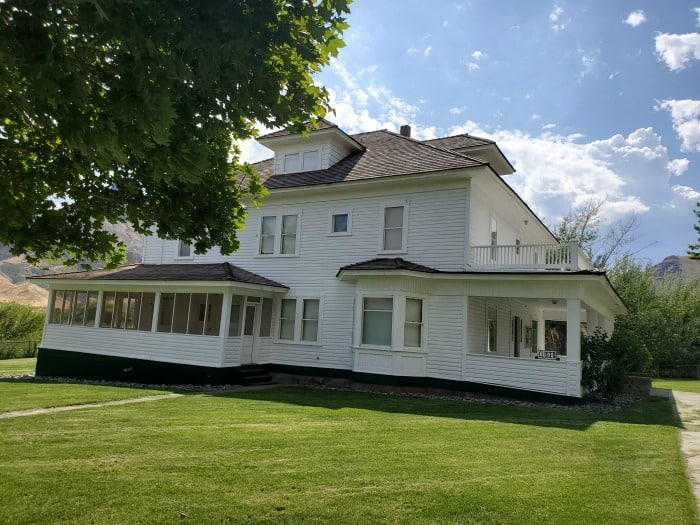
James Cant Ranch Historic District
After finishing at the Condon visitor center, a worthwhile stop is just up the road about one-half mile. The restored James Cant Ranch served as the original visitor center after the National Park Service purchased the property when the monument was established in 1975.
Cant was a Scottish immigrant who bought land on both sides of the John Day River and raised sheep as well as a family. Floyd Officer was the homesteader whom Cant purchased the land and original house from in 1910. Floyd Officer actually accompanied Condon on his diggings.
The new house was built in 1917 and a few rooms are open for public viewing. Vintage objects are displayed and history and daily life of Cant's family and area are explained.
There were actual range wars between cattlemen and sheepherders. Besides the house, visitors can wander the grounds and see all the buildings which are intact such as the bunkhouse, chicken coop, and privy.
The sheep shed is where hands sought comfort from the elements during all-night vigils during lambing time. The barn is huge and off to the side are sheep shearing pens. Hay stacker, plows, and other vintage farm machinery are scattered.
Behind the house is the orchard and the park service still grows hay in the fields. Visitors can imagine the life of the Cant family going about their daily business with a river inhabited by salmon in their backyard and all under the shadow of the hills. The Cants could no doubt have looked out from their back porch and observed fossil diggers at work.
From here, you can take the River Trail that takes you out to the John Day River. It is .6 miles round trip from the Cant Ranch parking lot.
You can also take the Sheep Rock Overlook Trail that ends with a view of the valley and river. It is .5 miles round trip.

Hiking at Sheep Rock Unit
The Sheep Rock Unit offers several scenic hiking trails and overlooks in four different locations with the most strenuous hikes located at the Blue Basin Trailhead.
Blue Basin Overlook Trail
The Blue Basin Overlook Trail is located at the Blue Basin Trailhead and is a 3.25-mile loop trail with over 600 feet of elevation gain/loss. Those brave enough to hike this trail get rewarded with spectacular views of the John Day River Valley.
Island In Time Trail
This is a 1.3 mile round trip trail that takes you into the amphitheater of blue-green claystone of the John Day formation!.
Story in Stone Trail
This .3 mile round trip trail takes you out to the base of some of the breathtaking blue-green claystone!
Flood of Fire Trail
This 0.4-mile round trip takes you out to a beautiful vista of the John Day River Valley.
Park Ranger John Pro Tip
For those who only do their research on Instagram and pretty pictures only can easily miss out on the Sheep Rock Unit as they run straight to the Painted Hills and get their photo of the Painted Hills and leave.
I was personally awestruck from the first moment I looked out into the green layers of claystone found in the Sheep Rock Unit. Did I mention there were no crowds!
To really get a close personal experience of this amazing area, lace up your boots, grab your water, and hit one of these trails: Story In Stone Trail, Island In Time Trail, or the Blue Basin Trail. You might just come back with a photo that all the Instagram followers will be drooling over!

Painted Hills
The Painted Hills Unit is aptly named for the red and gold beauty of the hills which can be viewed on the trails. The Painted Hills Unit is located 9 miles northwest of Mitchell along Burnt Ranch Road, which intersects U.S. Route 26 west of Mitchell.
The Painted Hills of Oregon are some of the most beautiful rock formations you can see within the National Park System. When you think of John Day Fossil Bed National Monument it is probably photos from the Painted Hills that you have seen in the past.
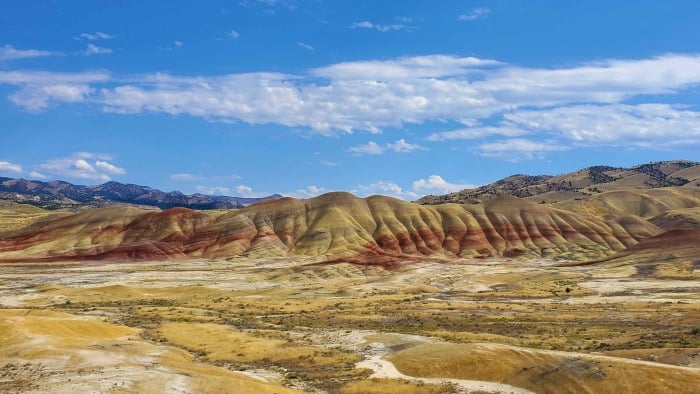
Things to do at the Painted Rocks Unit
Most visitors to John Day Fossil Beds come to see the painted hills. This is for good reason, everywhere you turn on social media, you see photographs of these colorful rocks!
Picnic Area
It is a drive to get to John Day Fossil Beds! Making it to the Painted Hills is a good time for a picnic. I personally enjoyed the green grass, shade, and restrooms that were available, especially after being out in the sun hiking. in the Painted Hills area.
Painted Hills Overlook & Trail
The Painted Hills Overlook and trail is on the left side of the dirt road past the picnic area. This is a definite must-see in the Painted Hills area. The views here are a photographer's dream. I was mesmerized by the dark blue skies, fluffy white clouds that perfectly framed the gorgeous Painted Hills of Oregon!
Carroll Rim Trail
If you want to go for a little longer of a hike, walk across the street and take the Carroll Rim Trail. This 1.6-mile roundtrip hike has over 400 feet in elevation gain and gives you those panoramic views of the Painted Hills!

Take a Short Hike on the Painted Cove Trail and Leaf Hill Trail
The Painted Cove Trail is the location that everyone wants to stop at and get the photo above. The trail itself is a short ¼ mile round trip out and back trail and the boardwalks make it easy for anyone to get an up-close and personal experience of the Painted Hills. continue past the red rock up the hill for a view looking down on this beautiful location!

The Leaf Hill Trail is another short .25 mile round trip loop trail. This is an area of the park that has been extensively excavated and studied by paleontologists and the Park Service has put out several interpretative signs explaining the history of the area.
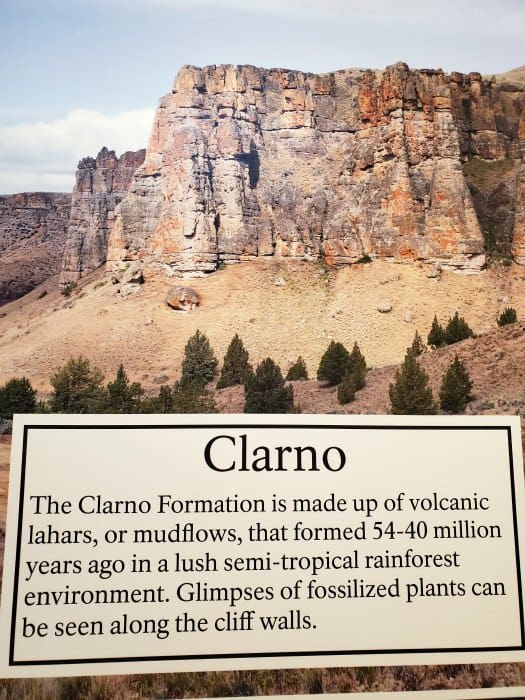
Clarno Unit
Hancock Canyon in the Clarno Unit has been a treasure trove of the oldest finds. The Clarno Formation was created 54- 40 million years ago is as made up of Volcanic lahers or mudflows. The public may only view the monument border along Highway 218 or one of its three short trails.
Things to do at the Clarno Unit:
Clarno Arch Trail
The Clarno Arch Trail is a short .25 mile roundtrip trail with a 200' accent up under a natural arch.
Trail of the Fossils
Trail of the Fossils is a .25 mile loop trail that offers the only opportunities to readily see fossils in rocks!
Geologic Time Tail
The Geologic Time Trail (.25 mile each way) takes and ordinarily connector trail (From the Picnic area and trail head) where each foot of trail represents 37,000 years!
The John Day Fossil Beds National Monument is a fascinating journey into a time when the terrain was totally different from the beautiful vistas seen today.

Things to know when planning a trip to John Day Fossil Beds National Monument
Thomas Condon Paleontology Visitor Center
Memorial Day through Labor Day Hours: 9 am - 5 pm daily
March-May & Sept. - Oct. Hours: 10 am - 5 pm daily
Nov. - Feb. Hours: 10 am - 5 pm, Open Tues. - Sat. Closed Sun. & Mon.
There is snow during winter and it gets hot in summer.
At all trails and areas in the monument, visitors are warned to be wary of rattlesnakes.
Entrance Fees - $0.00 there is no fee to visit the park
Learn more about National Park Passes for parks that have an entrance fee.
$80.00 - For the America the Beautiful/National Park Pass. The pass covers entrance fees to all US National Park Sites and over 2,000 Federal Recreation Fee Sites for an entire year and covers everyone in the car for per-vehicle sites and up to 4 adults for per-person sites.
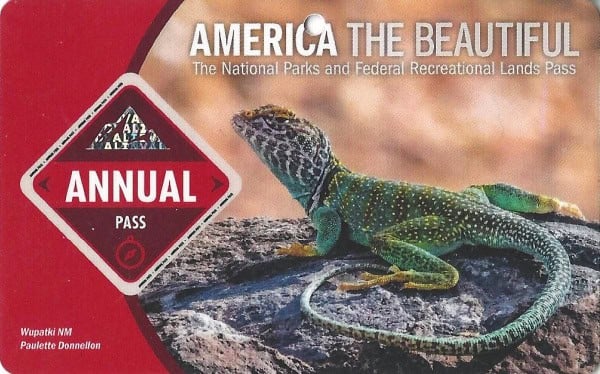
Buy your pass at this link, and REI will donate 10% of pass proceeds to the National Forest Foundation, National Park Foundation, and the U.S. Endowment for Forestry & Communities.
National Park Free Entrance Days -Mark your calendars with the free entrance days the National Park Service offers for US citizens and residents.
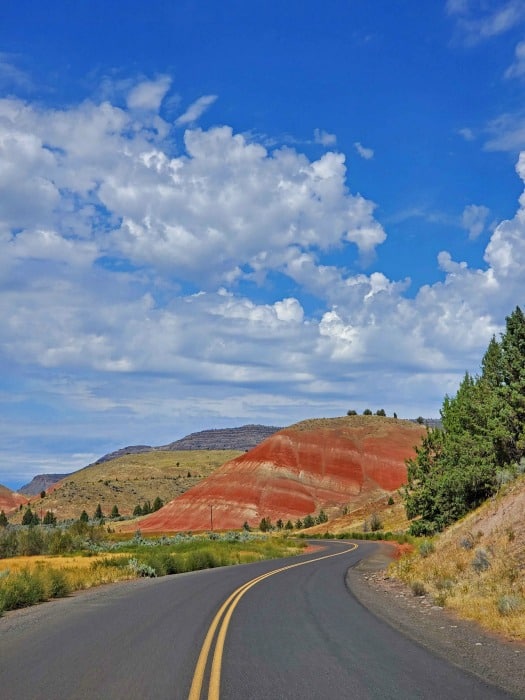
Camping - Camping is not allowed in any of the John Day Fossil Beds National Monument units.
Gas - Make sure you have a full tank of gas. Oregon requires someone to pump your gas and stations have limited hours, especially in small towns.
Oregon Trail - Keep an eye out for Oregon Trail markers as you drive to the park.
What to pack
John Day Fossil Beds NM is located in a pretty darn remote part of Oregon. You will want to be prepared when you head to the park.
Summers are HOT!!! The shade is a rarity that is mainly man-made from bulletin boards. Make sure you bring sunglasses, a hat, sunscreen, and a water bottle.
You will want to pack lunch and snacks with you. There are small towns semi-close to the park with a few dining options.
Camera Gear we use
We are big fans of using great camera gear to get amazing photos while traveling.
Canon R5 - We recently upgraded to the R5 after using a Mark 5 for years. We are loving the camera shutter speed and quality of images.
Canon 100 - 500mm - We use the Canon 100-500 for wildlife photography.
Camera Rain Cover - A rain cover will help protect your camera during rain showers but also when photographing waterfalls.
Camera Cleaning Kit - Cameras can get dirty, beat up, and dusty while in the parks. We like having a cleaning kit with us so we can do on the spot touch ups.
Extra Camera Batteries - We suggest always having one or two extra camera batteries with you. There is nothing worse than going to take a shot and the battery dies.
Extra Memory Cards - We use Extreme PRO SanDisk cards


Junior Ranger Program - The Junior Ranger booklet can be picked up at the visitor center. You can also do part of the Junior Ranger Program at home. Check out this article on how to earn your badge from home.
National Park Sites near John Day Fossil Beds NM
Whitman Mission National Historic Site
Manhattan Project National Historical Park - Hanford, WA
Nez Perce National Historical Park
Fort Vancouver National Historic Site
Check out all of the National Parks in Oregon and bordering Washington National Parks and National Parks in Idaho
Make sure to follow Park Ranger John on Facebook, Instagram, Pinterest, and TikTok





Leave a Reply